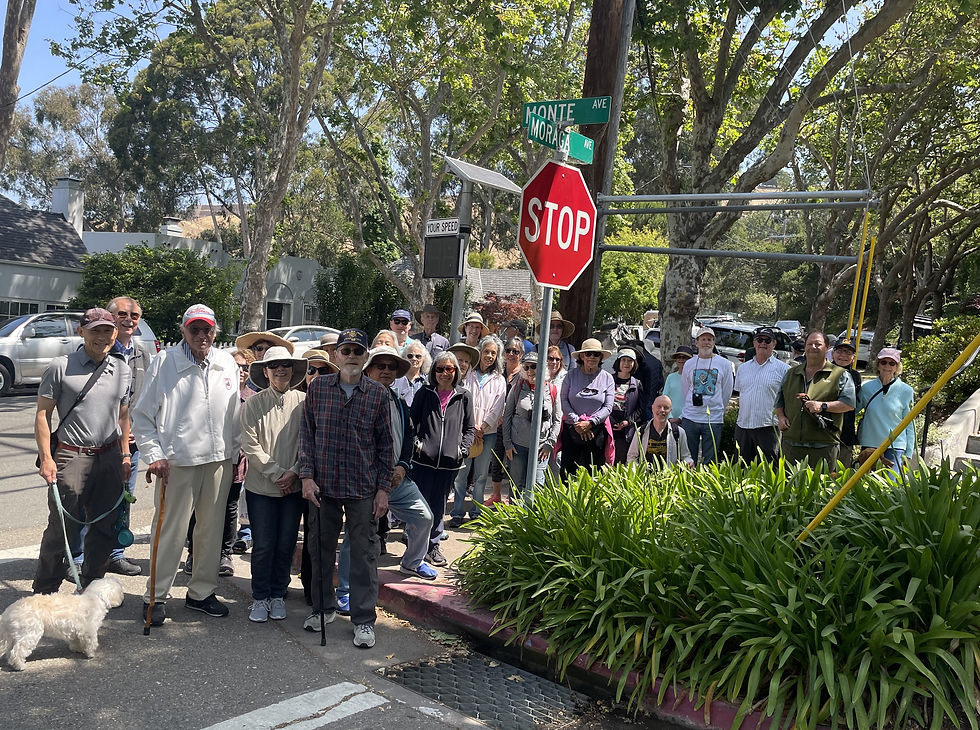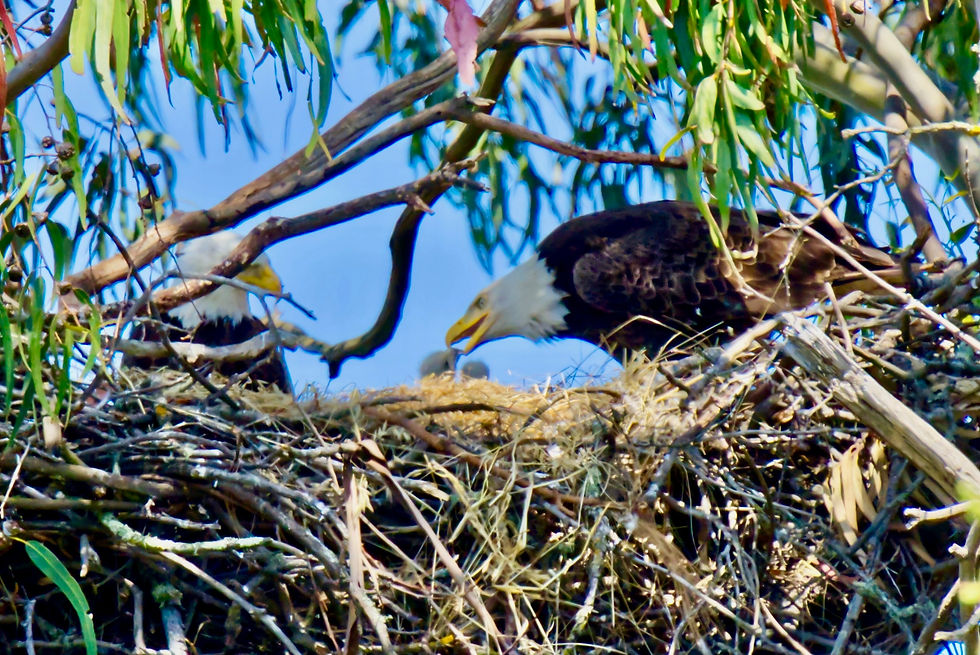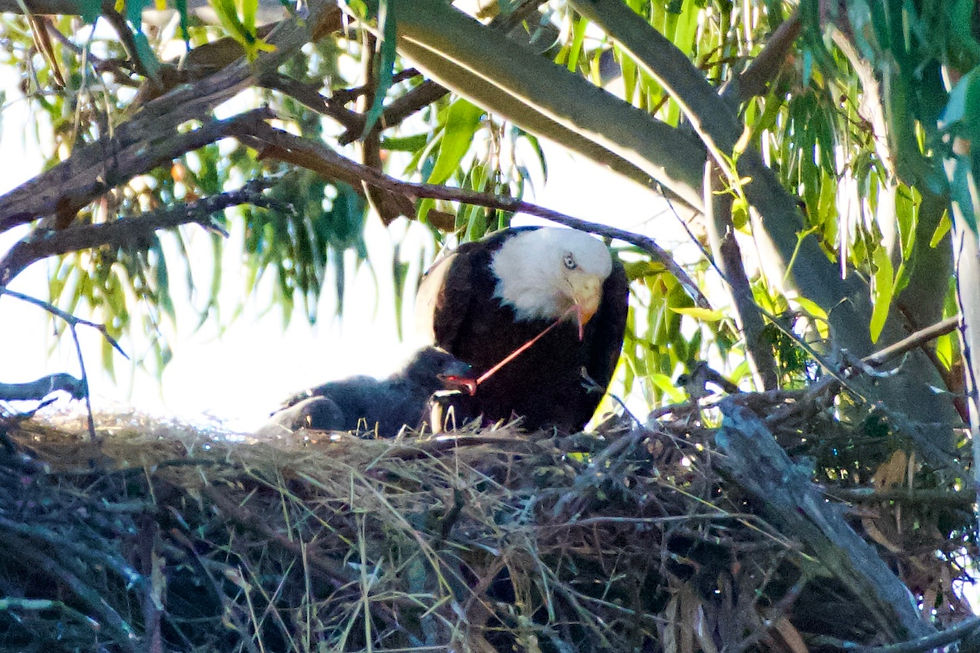Soaring Sights: Eagle Encounters with Piedmont’s Walking Group
- Walking On Wednesdays
- Jun 4
- 5 min read

Our Piedmont Recreation Department’s Walking on Wednesdays group had a lovely morning last Wednesday for a fun walk.
Recent news reports said there have been a higher-than-normal number of eagle sightings in the Bay Area. Air quality improvements in the area and a year of plentiful rain that have filled the reservoirs where eagles seek food could be behind the increase.
A pair of bald eagles have been nesting in a eucalyptus tree at the edge of Mountain View Cemetery near one of the cemetery’s reservoirs. Their eaglets had hatched, but since they typically don’t leave the nest, or “fledge,” for between 10 and 14 weeks, the new family would still be in residence. Additionally, a pair of owls in Dracena Park were the subject of a recent City naming contest. After looking for the eagles, we could search for them too.
There was a good turnout of 40 walkers and three K-9 best friends at the Exedra ready for bird watching fun. Among those participating were Doug Higashi with K-9 best friend Lucy, Jim Kellogg, Martin Levy, Judy Sokoloff, Claudine Bach, Stella Houston, Peggy Shultz, Brenda Ferrero, Denny McGee,
We went down Highland Avenue to and up Moraga Avenue. Bird watchers had been on the corner of Monte and Moraga Avenues, but State Fish & Wildfire guidelines instruct viewers to stay at least 330 feet from nests. While eagles can be curious about humans and even seem to recognize individuals who regularly observe them, they are not inherently "friendly" with people. Bald eagles are territorial, particularly during nesting season, and can be aggressive when they feel threatened, especially when defending their nests or young. Moraga Avenue traffic isn’t bothering them, but eagles are generally scared by loud noises, large, moving objects, and the presence of humans, so it is good to view them from a safe distance. We stopped at Mesa, the street before Monte, for some information about eagles.
Bald eagles weigh 10-14 pounds and have wing spans of 6.5 to 7 feet. Males are smaller than females. Eagles are not built for speed flying, but they can fly at about 30 mph and dive at over 100 mph. Their large, broad wings suit them for soaring and scanning, not chasing and maneuvering.
Bald eagles typically live between 20 and 30 years in the wild. The oldest bald eagle on record lived to be 47 years old. Young bald eagles are dark in color but develop their characteristic white head and tail at about four to five years.
Eagles only live in North America and are especially prevalent near coastal regions or large inland lakes and rivers with healthy fish populations. They mainly eat fresh fish, which they snatch out of the water with their sharp, curved talons. When eagles can’t find fish, they will eat ducks, small mammals, and dead and decaying animal flesh, often considered “roadkill,” and have been known to hunt small domestic cats.
Nests are built with large sticks and may be lined with moss, grass, plant stalks, lichens, seaweed, and sod. They are usually about 4 to 6 feet in diameter and 3 feet deep, although larger nests have been seen. Eagles primarily sleep on tree perches, not in their nests, either at them or nearby, especially during the breeding season to guard their young. Eagles have a specialized mechanism in their foot that allows them to lock it while they are sleeping.
Bald eagles come out during the daytime. They often eat after sunrise but can hunt anytime in daylight. Eagles’ eyesight is incredible. They can see a rabbit running up to three miles away or a fish down in the water, but eagles don't have good night vision. They need to find a branch and tuck in at night until the morning. This is different from another type of raptor, owls, who are nocturnal and have excellent night vision. Eagles’ hearing is similar to humans, okay, but not great. They also do not have a very well-developed sense of taste and smell. This benefits them because they are scavengers.
Their breeding season lasts from about January through July or August. Bald eagles mate for life, like some humans. Both the male and female work together to construct a nest, usually high in a living tree. They typically return to the same nest each year, adding new material with every breeding season, so Piedmont’s eagles may be back next year. Males and females share incubation responsibilities, but the female typically spends more time on the nest.
The process of eaglets leaving the nest can be gradual, with the young ones initially branching out to nearby areas before fully taking flight. Before fully leaving the nest, eaglets may start "branching" to nearby branches but still remain in the area. They often remain nearby for several weeks or even months, learning to hunt and fly from their parents. Like humans, parents continue to feed their young even after they leave the nest, helping them develop their life skills.
While bald eagles once nested along the entire Pacific Coast, from the Aleutians to Baja California, there were only 487 nesting pairs remaining in the lower United States in 1963. The decline was a result of habitat destruction and degradation, the use of DDT, and illegal shooting. In 1976, the eagle was officially listed as an endangered species, and conservationists took steps to save them. Bald eagles are protected under the Bald and Golden Eagle Protection Act which prohibits hunting, selling, possessing eagles, or taking their feathers, nests, and eggs. A 1972 nationwide DDT ban and restrictions on lead birdshot and lead fishing weights also helped restore eagle populations. By 1995, bald eagles were relisted as threatened.
Seeing a bald eagle now is not considered rare. Populations have significantly recovered, and they are now common in many regions of North America. Alaska has the most bald eagles in the United States, with an estimated population of around 30,000 birds, and about five now in Piedmont.
We continued up to Monte and found three bird enthusiasts. Many of us had brough binoculars, but one of the three let us view the nest through his telescope. He said one of the birds had recently flow off, but we were only able to see small heads popping up and an occasional little wing in the large nest.
We could probably have spent the entire morning looking off at the distant nest, but we wanted to see if we could find the owls in Dracena Park too, so we retraced our steps back Moraga and Highland and then to Park Way and the top of the park. We scoured the treetops, looking for the owls, recently named Ramona and Blair, but these night-lovers were not to be seen. It was a bit of a disappointment, but we agreed that any time spent in beautiful Dracena Park is time well spent. However, it was almost noon, and time to put our binoculars away for a return to the Exedra via Blair, Hillside, and Magnolia Avenues.








Comments